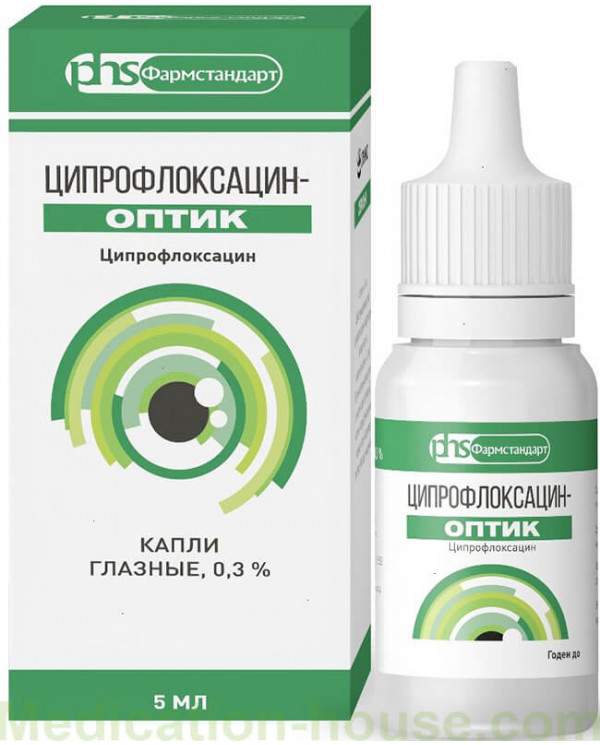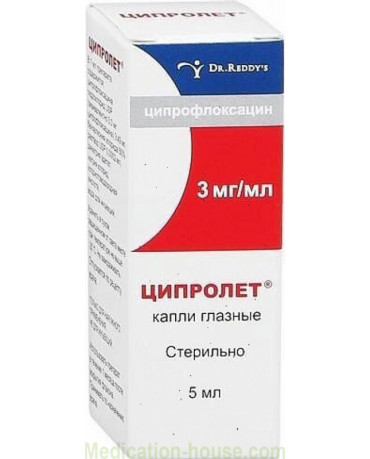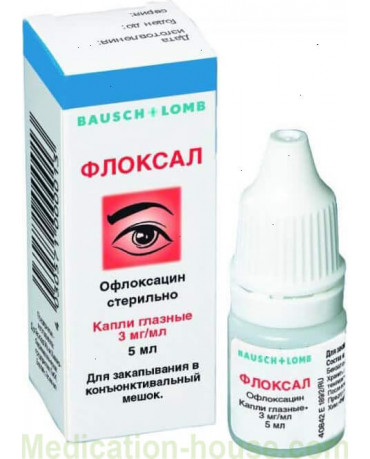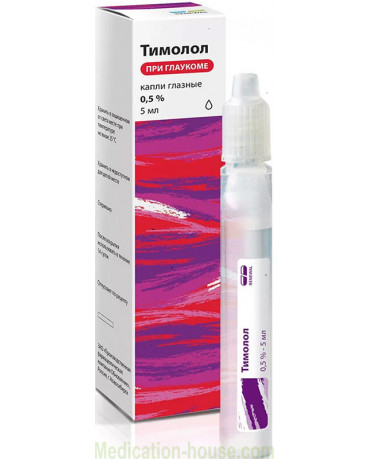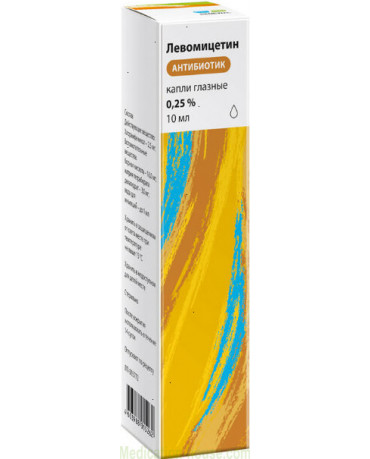Instruction for eye drops Ciprofloxacin
You can buy Ciprofloxacin eye drops on this page
Description of the drug
Ciprofloxacin - broad-spectrum eye drops. Antimicrobial and antibacterial action is based on the content of an antibiotic, which is effective against many groups of pathogens. They have several advantages:
low cost;
availability and dispensing without a prescription;
rapid suppression of pathogenic microflora;
the minimum number of side effects.
The drug in drops is easy to dose, so it is recommended for home treatment. In a severe form of the disease, it can be combined with the simultaneous administration of an antibiotic in tablets.
Composition and form of release
The main active ingredient is ciprofloxacin hydrochloride monohydrate. It is a modern and high-quality antibiotic that suppresses many types of pathogenic bacteria. The preparation contains medicinal components and preservatives:
mannitol;
sodium acetate trihydrate;
acetic acid;
benzalkonium chloride.
The solution has a yellow tint, non-oily structure, when shaken does not give sediment or cloudy impurities. The dropper bottle made of transparent polyethylene is supplemented with a convenient dispenser and is easy to use.
Drug action
When absorbed into the tissues affected by bacteria, drops of Ciprofloxacin affect only the cells of the pathogen. They destroy the DNA gyrase of topoisomerase II, without which further reproduction does not occur. The active substance stops the growth of pathogenic microflora at any stage, prevents the formation of new colonies.
Among the positive properties of drops - there is no risk of addiction to the drug. They with high efficiency infect the most resistant subspecies of microbes and bacteria that do not respond to treatment with tetracycline and penicillin. They are recommended when the following pathogens are found in the crop:
aerobic;
enterobacteria;
gram negative;
gram-positive;
intracellular (Listeria, Chlamydia, Legionella).
In case of eye damage with staphylococcus, eye drops are prescribed in a higher dosage due to resistance to ciprofloxacin derivatives.
Indications for use
Ciprofloxacin eye drops are often recommended in ophthalmology for the treatment of infectious and inflammatory diseases. The list, from which the drug helps, includes the following pathologies:
acute form of conjunctivitis;
blepharitis;
complications against the background of keratitis;
bacterial corneal ulcer;
dacryocystitis;
barley.
The use of the composition is indicated after removal from a speck or shavings to prevent infection with bacteria. For children over 1 year old, the drug is used in the treatment of conjunctivitis.
For women, the medicine is recommended after eyelash extension with hygiene violations, if the eyelids are very red, patches contain allergens or substances toxic to the skin.
Instructions for use
If the doctor has prescribed Ciprofloxacin eye drops for treatment, the instructions for use of eye and ear drops recommend using the following scheme:
In acute form with abundant discharge of purulent fluid, instill 1-2 drops no more than 4 times a day.
In severe bacterial inflammation, 1 drop should be administered every 2-3 hours. After a day, the dosage is reduced to standard.
Bacterial ulceration on the cornea should be treated with 1 drop every 15-30 minutes for 5-6 hours. Further dosage - 1-2 drops in 6-8 hours.
To prevent infection after surgery or to remove debris, Ciprofloxacin eye and ear drops are used for 3 days, once every 10–12 hours. In childhood, the dosage is selected by an ophthalmologist individually, depending on body weight, severity of the disease.
The method of using drops is simple. It is necessary to thoroughly wash and dry your hands, open the bottle with a napkin. Gently pull back the lower eyelid and instill the medication into the conjunctival sac. After the procedure, close your eyes for a few seconds so that the liquid is distributed over the eyeball.
The instruction does not explain whether a liquid antibiotic can be dripped into the nose. But there are practical examples that it helps to reduce inflammation in the sinuses with rhinitis, sinusitis or frontal sinusitis.
With a complicated course of eye infections, doctors prescribe an additional intake of an antibiotic in the form of a dropper. For one procedure, ciprofloxacin is used in a dosage bottle of 100 ml intravenous infusion.
Contraindications and side effects
Eye drops with Ciprofloxacin are generally well tolerated by patients. Complications in the form of an allergic reaction to one of the components rarely occur. It is expressed in characteristic symptoms:
itching;
burning;
slight soreness:
redness of the sclera;
slight swelling of the eyelid.
With individual intolerance, hypersensitivity to bright light, a feeling of "sand" on the cornea may be observed. Patients note that the tear is released in a smaller volume, leaving painful dryness.
Among the contraindications to treatment with Ciprofloxacin drops:
keratitis (only viral form);
age up to 1 year;
drug intolerance.
The controversial point is treatment during pregnancy and breastfeeding. The antibiotic can concentrate in a small amount in the patient's blood, so its use is allowed only in extreme situations.
Additional Information
The medicinal product is not intended for injection or eye rinsing. If simultaneous administration with other medicinal drops is recommended, an interval of at least 10-15 minutes should be maintained. On the first day, it is necessary to carefully monitor the manifestation of allergies.
When instilling ciprofloxacin eye drops, it is recommended to temporarily stop wearing contact lenses. Some patients add them to conjunctivitis storage solutions for disinfection. Drivers should be careful: in rare cases, cloudy eyes are observed.
Overdose
There are no registered cases of overdose with drops of Ciprofloxacin: the concentration of the antibiotic is only 0.3% per bottle. In case of accidental use of the medicine inside, it is necessary to rinse the stomach or drink activated charcoal.
Storage conditions
The shelf life and storage of the composition are indicated in the instructions. They are left sealed in a dry place for 3 years. After opening, the solution must be used within 30 days: after their expiration, the antibiotic loses its medicinal properties. Drops should be protected from exposure to sunlight.
Interaction with other medications
When used simultaneously with other anti-inflammatory drugs, there is no manifestation of allergies or side effects. But it has been proven to accelerate the absorption of some anticoagulants and drugs based on caffeine. Use with cyclosporine may temporarily increase blood creatinine.
Drops should not be taken together with alkaline solutions: the latter reduce the healing properties of the antibiotic.
Reviews of the drug
Elena, 32 years old
Spring allergy for me ended with severe conjunctivitis, severe pain and going to the doctor. The ophthalmologist recommended an inexpensive option - Ciprofloxacin drops. In the first days, it dripped often - every 4 hours. A day later, I noticed that the pain had decreased, the edema began to subside. I recommend it as an excellent drug for a very low price!
Victoria, 27 years old
My son often has problems with his eyes: he will rub his dirty hands after a sandbox and conjunctivitis and redness appear. Recently, barley jumped out, the eyelid puffed up, I had to see a doctor. In addition to washing with chamomile, I prescribed drops of Ciprofloxacin. We were pleasantly surprised by the price. The medicine helped to cope with the disease, so now I always keep it close at hand.
Terms of sell
You don't need a prescription from a doctor to buy Ciprofloxacin eye drops.

